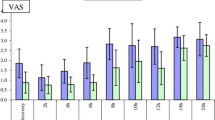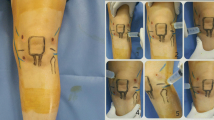Abstract
We tested the effectiveness of different intra-articular analgesics and of pre-emptive intra-articular analgesia for arthroscopy-assisted anterior cruciate ligament reconstruction (ACLR) and for operative knee arthroscopy. Eighty-two patients underwent operative knee arthroscopy under selective subarachnoid anaesthesia (group A), and 60 patients underwent arthroscopy-assisted ACLR under general anaesthesia (group B). Patients were randomly assigned to intra-articular analgesic treatment as follows. Group A: 1, morphine 2 mg; 2, preoperative morphine 2 mg; 3, morphine 5 mg; 4, preoperative morphine 5 mg; 5, bupivacaine 0.25% 20 ml; 6, bupivacaine 0.25% 20 ml + morphine 2 mg; 7, saline solution 20 ml. Group B: 1, morphine 2 mg; 2, morphine 5 mg; 3, preoperative morphine 5 mg; 4, bupivacaine 0.25% 20 ml; 5, bupivacaine 0.25% 20 ml + morphine 2 mg; 6, saline solution 20 ml. All opioids were diluted in 20 ml of saline solution. After postoperative administration the tourniquet was left in place for 10 min. After preoperative administration the intra-articular surgical procedure was delayed for about 5–10 min. In the postoperative period we recorded: total consumption of ketoprofen given i.v. on demand as rescue analgesic treatment; pain scores before surgery and at 1st, 3rd, 6th, 12th and 24th h; occurrence of local anaesthetic or opioid side-effects. Group A (operative knee arthroscopy): all morphine groups (A1, A2, A3, A4) and the bupivacaine group (A5) did not require ketoprofen postoperatively (P < 0.01 vs both groups A6 and A7). Pain scores did not differ significantly among groups. The percentage of patients reporting higher pain scores than before surgery was larger in control group A7 and in bupivacaine groups A5, A6 (83%, 40%, 60%, respectively) and lower in morphine groups A1, A2, A3, A4 (25%, 16%, 27%, 23%, respectively). Group B (ACLR): total consumption of ketoprofen was lowest in groups B2 and B3 (P < 0.001 vs all other treatments and vs control group). The percentage of patients who did not require any rescue analgesic was 60% in group B3, 50% in group B2, 32% in group B5 and 0% in all other groups. No-side effects occurred in any patient. Intra-articular analgesia is safe and effective for arthroscopic knee surgery. Morphine provides a better pain control both in operative knee arthroscopy patients and in ACLR. A 2 mg dose is adequate for operative knee arthroscopy but not for ACLR, where higher dosages are required (5 mg). Pre-emptive intra-articular morphine provides better analgesia than postoperative administration.
Similar content being viewed by others
Author information
Authors and Affiliations
Additional information
Received: 25 May 1996 Accepted: 28 April 1997
Rights and permissions
About this article
Cite this article
Denti, M., Randelli, P., Bigoni, M. et al. Pre- and postoperative intra-articular analgesia for arthroscopic surgery of the knee and arthroscopy-assisted anterior cruciate ligament reconstruction A double-blind randomized, prospective study. Knee Surgery 5, 206–212 (1997). https://doi.org/10.1007/s001670050051
Issue Date:
DOI: https://doi.org/10.1007/s001670050051




